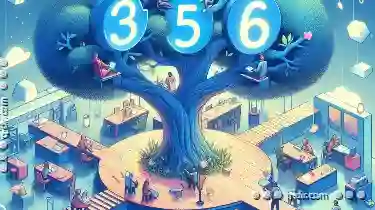One such method is the tree view, which is widely used in various software applications to represent hierarchical data. Despite its widespread use, a ...
 significant limitation of tree views remains that they often struggle to effectively capture and represent relationships among elements within their structure. This blog post will explore why tree views are fundamentally limited by their focus on containment rather than true relationship representation, using the concept of graph theory as a framework for understanding these limitations. In the world of user interfaces, navigation and display methods are crucial for enabling users to interact with complex information structures efficiently.
significant limitation of tree views remains that they often struggle to effectively capture and represent relationships among elements within their structure. This blog post will explore why tree views are fundamentally limited by their focus on containment rather than true relationship representation, using the concept of graph theory as a framework for understanding these limitations. In the world of user interfaces, navigation and display methods are crucial for enabling users to interact with complex information structures efficiently.1. Understanding Containment in Tree Views
2. The Limitations of Containment
3. Graph Theory Perspectives
4. Advantages of Graph-Based Representations
5. Conclusion
1.) Understanding Containment in Tree Views
A tree view is structured based on the principle of "containment." Each node within the tree represents an item that can contain other items (child nodes). This hierarchical structure implies a parent-child relationship where each child directly belongs to its parent. For instance, in a file system, directories are parents and files are their children; this is an example of direct containment.
2.) The Limitations of Containment
1. Single Parent Nodes: In a tree view, nodes can have only one direct parent. This single-parent rule limits the complexity of relationships that can be represented. For example, if you want to represent a many-to-many or non-linear relationship (like in social networks where multiple people are friends with each other), a tree structure cannot handle such complexities effectively.
2. Flattening Relationships: When dealing with more complex hierarchical relationships that span multiple levels and include various connections, like in organizational charts or family trees, the flat containment model becomes inadequate because it requires manual insertion of nodes at specific hierarchy levels, which can lead to confusion and errors.
3. Visual Clutter: The use of indentation lines and nested structures in tree views can create visual clutter, making it difficult for users to discern deeper relationships among elements that are not directly parent-child but still related through other hierarchical paths or intersections.
3.) Graph Theory Perspectives
From a graph theory perspective, a tree is a specific type of graph where each node has at most one connection (the edge) to its parent and zero or more connections to children. However, real-world relationships are often better represented as graphs rather than trees. A graph allows for multiple edges between nodes, representing complex, non-linear relationships.
Graph databases like Neo4j, Amazon Neptune, and Microsoft’s Graph Engine exemplify this approach by using nodes and directed or undirected edges to represent entities and their relationships. These systems are designed to handle more complex queries and traversals across different types of relationships (e.g., friend of a friend in social networks) that traditional tree structures cannot manage efficiently.
4.) Advantages of Graph-Based Representations
1. Multiple Relationships: Unlike trees, graphs can represent multiple connections between nodes, allowing for much richer and more complex relationship modeling. This is particularly useful in scenarios where relationships are not hierarchical but network-like (e.g., supplier-supplier, customer-customer).
2. Efficient Querying: Graph databases support efficient querying across different types of relationships through graph traversal algorithms like Breadth-First Search (BFS) and Depth-First Search (DFS). This is not possible with flat tree structures where finding related items often requires complex queries or multiple traversals.
3. Flexibility in Relationship Representation: Graphs provide flexibility to represent asymmetric relationships, cycles (like friend circles), and even indirect relationships through traversal of the graph structure without hardcoding every relationship into a hierarchical model.
5.) Conclusion
While tree views are intuitive and useful for representing direct containment hierarchies like file systems or organizational structures, they fall short when it comes to representing complex, non-hierarchical relationships in data models. Graph-based representations offer a more robust solution that can handle multiple types of relationships efficiently and intuitively, making them suitable for modern applications requiring sophisticated relationship modeling beyond simple containment.
As user interfaces continue to evolve with the needs of increasingly complex information architectures, it’s essential to recognize and leverage tools like graph theory that are better suited for representing nuanced relational data.

The Autor: / 0 2025-05-03
Read also!
Page-

Is the Windows Explorer Shell a Security Vulnerability in Disguise?
Windows Explorer, also known as File Explorer or simply Explorer, is a fundamental component of Microsoft Windows operating systems. It serves as the ...read more

How Filters Could Be Perfect (But Aren t There Yet)
Despite their ubiquitous use, filters often fall short in meeting expectations due to a few fundamental issues. This blog post will explore why ...read more

The Little-Known History of Tree View in Computing
From command lines to graphical user interfaces (GUIs), navigation tools have become increasingly sophisticated over the years. Among these tools, ...read more